 For 2009’s Grand-Am Rolex 24 at Daytona champion Joerg Bergmeister, the love affair with motorsports began early. “Motorsport was a family thing,” Bergmeister tells us. “My grandfather was a motorcycle racer and my dad was a very successful driver.” Indeed, Joerg’s grandfather was a Sachs factory motorcycle driver, and his father raced touring cars. “My brother and myself were involved in racing from very early in our childhood,” continues Bergmeister—brother Tim is also a professional sports car driver today.
For 2009’s Grand-Am Rolex 24 at Daytona champion Joerg Bergmeister, the love affair with motorsports began early. “Motorsport was a family thing,” Bergmeister tells us. “My grandfather was a motorcycle racer and my dad was a very successful driver.” Indeed, Joerg’s grandfather was a Sachs factory motorcycle driver, and his father raced touring cars. “My brother and myself were involved in racing from very early in our childhood,” continues Bergmeister—brother Tim is also a professional sports car driver today.
Like many racing greats before him, Bergmeister’s career started when he was aged three, with a Kart under the Christmas tree. “It is my earliest memory of [anything related to] racing,” he tells us. In 1993, fourteen years after he first sat in that kart, he raced and won the Formula Koenig series. The Formula Koenig, which ran from 1988 to 2003, was an entry level single seat series also notably won by Michael Schumacher in 1988.
Bergmeister didn’t rest on his laurels long. When asked if he remembers what the prize was for the Formula Koenig victory, he responds, “there was a little bit of prize money, but that went straight in the budget for the next year.” This focus and commitment served him well as he climbed higher and higher up the racing ladder, collecting impressive victories along the way.

As Bergmeister garnered more attention, he moved quickly through the ranks of racing, landing at the prestigious Porsche SuperCup (the international racing series supporting the FIA Formula One World Championship) organized by Porsche AG. The SuperCup, where drivers compete in identical GT3 Cup cars, is considered by many a true test of driver ability. For Bergmeister, who won the SuperCup in 2001, the transition from open wheel racing to the 996 was a natural one. “It definitely took a little bit getting used to the cars,” he tells us, “but at the end you can transfer a lot from karting to open wheel and from there to sportscars.” Some observers have noted that there seems to be more contact in the SuperCup (vs. Formula One, for example), but Joerg disagrees. “Actually, there is not too much contact in [the] SuperCup, as the 911 has the radiators right in the front bumper, and it is a pretty big risk to push someone else,” since without radiators the race is over. That said, in a race of equals, every little bit counts, and sometimes a little contact can happen. Continues Bergmeister, “in general, my rule is if [during a race] someone closes the door twice, the 3rd time there will be contact,” adding, “but it depends on the situation as well. For example, if you are in the running for a championship you take less chances.” If used strategically, Bergmeister affirms a little pushing can be beneficial: “[pushing] is always fun at Hockenheim, on the long straights. After the start on the first long straight it is normal to push or be pushed down the straight. It is the best way to pass other cars!”
ON BEING A PORSCHE FACTORY DRIVER
After his 2001 SuperCup victory, Bergmeister got an invitation many young drivers only dream about: the chance to test for a Porsche Factory Driver position. I ask him how this incredible opportunity came about, and he says, “after I won the SuperCup, Porsche asked me to race in the 24 hrs of Daytona as a test.” In his usual humble demeanor, he adds, “I was lucky enough to win that race and then was offered a contract.” Talent, not luck, probably had far more to do with it. In fact, he not only won the GT class in the Rolex 24 At Daytona in 2002, but also earned one victory, six podium finishes and one pole position in the ALMS GT class that year.
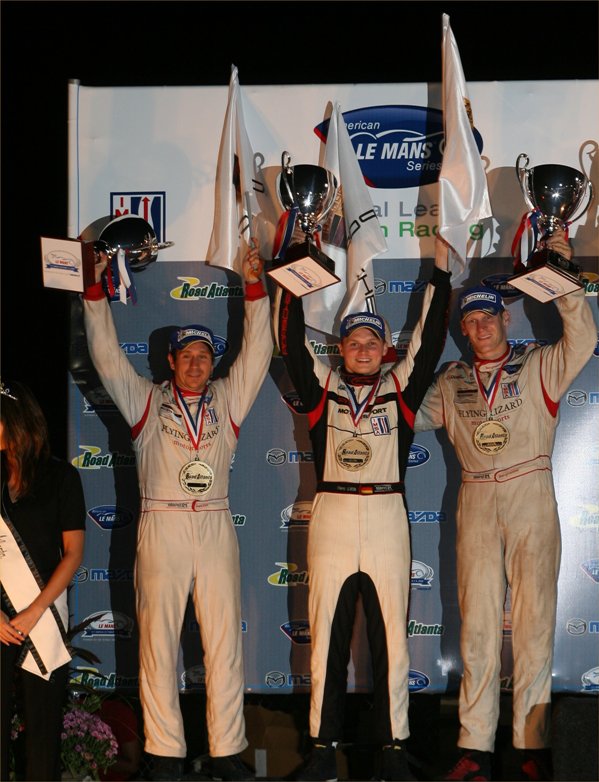
The job of Porsche Factory Driver includes racing for the Porsche marque and contributing to the development of Porsche race cars, plus, says Joerg, “everything that comes along with that.” Perhaps he is referring to the demanding travel schedule and the required Porsche Fitness Camps used to keep drivers in exceptional physical shape. Recently, at a ten day intensive camp on a Spanish island, drivers including Joerg worked hard on their power and endurance under the direction of a sport medicine specialist. Because physical fitness is such an inherent part of motorsport, it is not unusual to see Joerg update his Facebook status with, “Joerg Bergmeister is going to boot camp!”
In his capacity as a Factory Driver for Porsche, Bergmeister’s first assignment was to compete in ALMS under the Alex Job Racing team.
While he has proven his mettle in the American LeMans (ALMS) circuit plenty of times, Bergmeister is a diverse driver who excels in the GrandAm Rolex Series as well. I asked him what the greatest challenge of a race like Daytona or Sebring is, and Bergmeister replies, “the biggest thing is to concentrate,” adding that it is key to “stay focused and make no mistakes even though you are exhausted.” As for another legendary endurance race he has won – the 24 Heures du LeMans–“the biggest difference is that you are only allowed 3 drivers … so it means much more seat time for every driver, which I enjoy.”
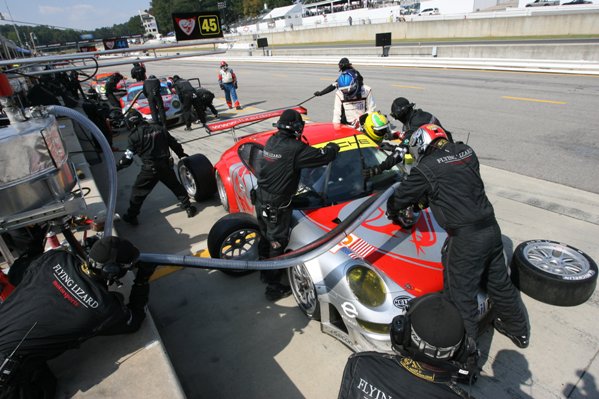
Moving on to the subject of American vs. European racing. Bergmeister says there are few, if any, significant differences in racing between continents. “The competition in Europe and the U.S.A. is pretty equal, so it takes the same amount of preparation,” he says. Likewise, Bergmeister does not think there is a general difference between American and European drivers; “there are just differences between each and every driver.” However, says Bergmeister, there is a little difference between American and European racetracks: “most of the tracks in the U.S. are a little more physical due to bumps.”
THE FLYING LIZARDS
In 2007, Bergmeister joined the illustrious Flying Lizard Motorsport team. “I was re-assigned by Porsche and they placed me at the Lizards, which I was really happy about,” he says. The Sonoma, California racing team was founded in 2003 by team principal (and driver of the No. 44 Porsche) Seth Neiman. The team is based in Sonoma, California at Infineon Raceway. Since 2004, its first year competing, the team has finished in the top three spots in the ALMS GT2 team and drivers’ championships. In 2008, with Joerg and Wolf Henzler piloting the no.45 car, the team won both the ALMS GT2 drivers’ and team championships.
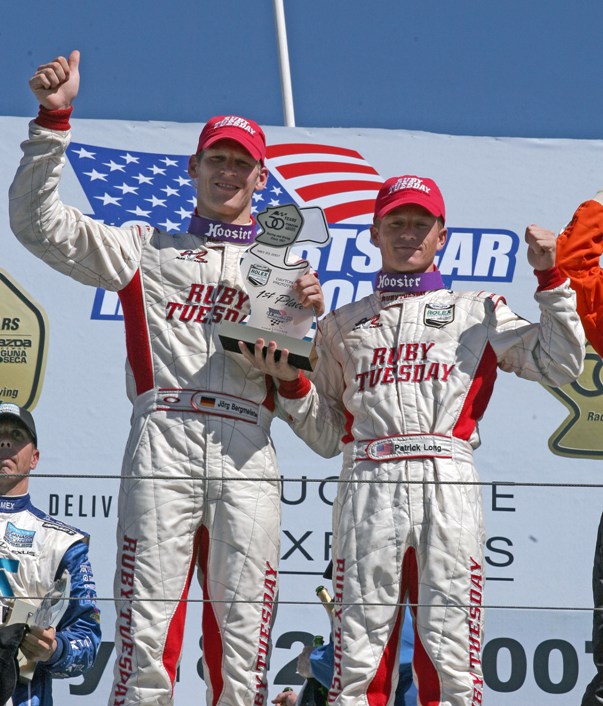
I ask about the challenge of balancing his own ambitions with those of his team as a whole?
Although Bergmeister and Long clearly enjoy working with one another, they are physically different—Bergmeister is quite tall at over six feet tall—and this requires compromise in car setup. To Bergmeister, compromise is an inherent part of teamwork. “Balancing one’s ambitions is a key point, especially on set-up. It helps to find a compromise and not just the best setup for yourself.” Always the consummate team player, Bergmeister doesn’t think long when asked to name a favorite teammate. “I have been teamed with so many great guys that it is hard to pick a single name,” adding that he prefers to stay focused on doing his job as part of a team. “The goal is to beat everyone else,” he asserts, “[then] we have done our job.”
THE ADVENTURE CONTINUES
Over the last decade, Bergmeister has been behind the wheel of many different cars including the Rolex GT spec GT3 Cup, various Daytona Prototypes (DP) and the Porsche 911GT3 RSR. All experiences have been enjoyable and challenging, Bergmeister tells us. “The cars are different, but it usually takes only a couple of laps to get used to the other car again.” In fact, “the driving style for both the DP and RSR cars is fairly similar. The [Daytona Prototype] has more downforce and the RSR has more mechanical grip.”

While victory has certainly not been elusive for Joerg Bergmeister, one year in particular stands out. “2006 was a special year for me,” he says; “winning 2 championships in one year is something that does not happen too often!” He is, of course, referring to the Daytona Prototype championship (with victories at Watkins Glen, Daytona and Barber), where he never finished lower than 9th in 14 races. Add to that the ALMS GT2 championship, and you can see why ’06 stands out in Bergmeister’s mind.
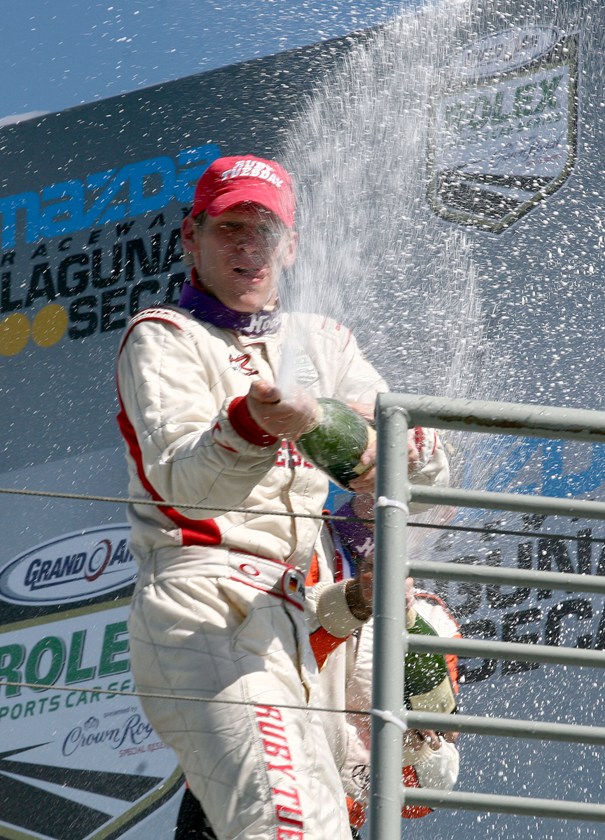
In 2009, the sixth consecutive ALMS season for the Flying Lizards, Bergmeister will be teaming up with American Patrick Long. He and Long have worked together before, winning the GT2 category at the prestigious 24 Heures of LeMans (along with Sascha Maasen) in 2004. The 2009 ALMS season spans 10 races throughout North America. The season kicks off in March with the Mobil 1 Twelve Hours of Sebring and concludes with the season finale at Laguna Seca on October.
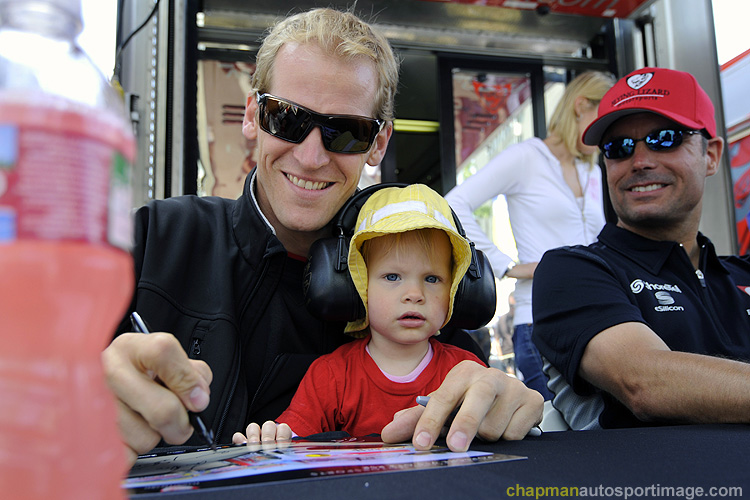
As he embarks on another promising year behind the wheel, Joerg’s family – wife Danielle and their little girl Lucy – stand behind him. I ask him how he would feel if his daughter were to show interest in racing, and he responds, “if she wants, we will start go-karting like her cousin already does,” adding, “then we will see what happens.” If she’s anything like her Dad, keep your eyes open for yet another Bergmeister on the podiums around 2030!
We would like to thank Joerg for taking the time to speak with FlatSixes.com’s Valerie Roedenbeck and for working with us while we prepared this interview. In addition, special thanks to Bob Chapman of AutoSportImage.com for use of his photos.
Related Posts
Stuck Father and Son team Join Bergmeister and Henzler at Sebring in a run for the Checkered Flag
Porsche and the American Le Mans Series
Porsche to Field Five 911 GT3 RSRs at the 2009 12 Hours of Sebring
Porsche Wins 12 Hours of Sebring
911 GT3 RSR Winter Testing at Sebring